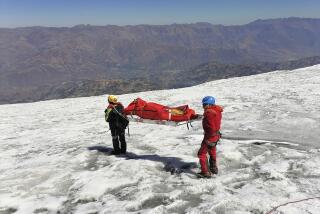It’s the stuff of climbing legend
- Share via
“We climbed because it was fun,” Joe Simpson says, simply and directly. “And it was fun. It was just brilliant fun. And every now and then it went wildly wrong and then it wasn’t.”
Wildly wrong turns out to be a rather mild description of what happened to Simpson and his fellow British climbing partner Simon Yates in the Peruvian Andes in 1985. A series of very bad things led to situations so agonizing and appalling their experience could legitimately have been called “The Worst Journey in the World” if the title weren’t already spoken for.
“Touching the Void,” a film based on Simpson’s book about the climb, is an attempt to do the impossible. Director Kevin Macdonald tries to painstakingly re-create the disastrous incident, using actors as well as the two actual climbers, in a way that is intended to make it seem completely real for an audience.
It’s a nervy, quasi-documentary scheme that’s often successful, perhaps more so than you’d expect for this kind of a hybrid endeavor. But Macdonald’s technique eventually turns out to be as distancing as it is involving, paradoxically undercutting the reality as often as it enhances it. While the tale is remarkable enough to compel our interest, this is a case of the story carrying the filmmaking rather than the other way around.
Macdonald is a documentary veteran whose excellent “One Day in September” on the Munich Olympic massacre won the 1999 documentary feature Oscar. You could almost feel him chafing at the limits of the form as he considered making a traditional film about a saga that, as a crawl at the beginning accurately but breathlessly informs us, “has become part of mountaineering legend.”
So, like a climber planning an ascent, Macdonald decided on a two-pronged attack, starting with the three men who lived the story, all of whom survived to tell the tale.
It’s a narrative the three of them, including casual acquaintance Richard Hawking, a non-climber who kept an eye on the tents, have likely told many times in the intervening years, and this turns out to be a surprising advantage.
Far from being as bored as you might fear, the adventurers, reflective and articulate men who’ve clearly thought this through, remember the story like it happened yesterday. Their impeccable recall, the gripping way they talk about an experience whose intensity still weighs on them, is much the most compelling part of “Touching the Void.”
The initial idea was to climb the previously unconquered west face of a 20,853-foot peak called Siula Grande. The climbers wanted to attack Alpine style, doing it in a single push without a base camp, a plan that “left no margin for error,” Yates acknowledges. “If something goes wrong, it can be very, very serious.”
And things proceeded to go very wrong on the descent, where apparently 80% of accidents happen. With the two climbers roped together, Simpson broke his leg in several places and found himself almost immobile and in excruciating pain.
Yates attempted to gradually lower his injured colleague down the mountain, but when Simpson was accidentally lowered over the edge of a cliff, all progress halted. Yates faced an awful decision: either cut the rope and sentence his crippled partner to near-certain death, or stay roped together and likely doom them both.
As Simpson and Yates are telling this story, we are, in a manner of speaking, seeing it being acted out on screen, with two actors with climbing experience, Brendan Mackey and Nicholas Aaron, playing the narrators. As Simpson talks about falling into a crevasse, we see the actor doing it, giving the film some of the feeling of the illustrated lectures adventurers Osa and Martin Johnson used to put on decades ago with wild animal footage shot in Africa.
Though the majority of “Touching the Void’s” climbing scenes ended up being shot in Europe rather than Peru, because they were photographed in some of the worst weather in years, the film manages a very convincing replication of climbing under adverse conditions.
But as much as the re-creation puts us into the story, it takes us out. In fact, the more intense the story gets, the more distracting becomes the contrast between the real people talking and actors we are increasingly aware are, not to put too fine a point on things, faking it.
The quality of the acting is not the problem, it’s the contrast between the fake and the genuine that makes the former insupportable. To have performers feigning agony while real agony is being discussed on the soundtrack is distracting at the very least. “I wanted my film to feel as real as possible,” Macdonald has said, and while “Touching The Void” is a worthy effort that accomplishes many things, it does not do that.
More to Read
Only good movies
Get the Indie Focus newsletter, Mark Olsen's weekly guide to the world of cinema.
You may occasionally receive promotional content from the Los Angeles Times.











